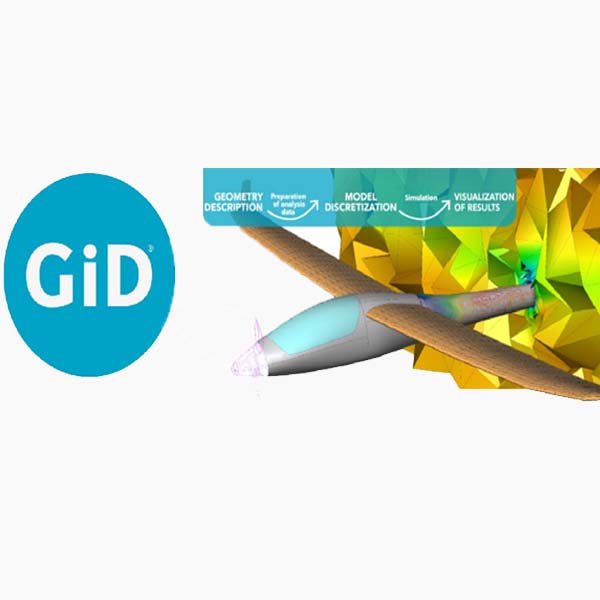Description
GiD is an universal, adaptive and user-friendly pre and post processor for numerical simulations in science and engineering. It has been designed to cover all the common needs in the numerical simulations field from pre to post-processing.
| Geometrical modelling (CAD) | Mesh generation |
| Definition of analysis data | Data transfer to analysis software |
| Post processing operations | Visualization of results |
GiD has been developed by the International Center for Numerical Methods in Engineering (CIMNE) (www.cimne.com), a research center with headquarters in Barcelona (Spain). CIMNE was created in 1987, linked to the prestigious Technical University of Catalonia (BarcelonaTech). CIMNE specializes in the development and applications of numerical methods and software to find solutions to a variety of problems in engineering and applied sciences.
Pre-processing
CAD system: GiD is a CAD system that features the widely used NURBS surfaces (trimmed or not) for geometry definition. A complete set of tools is provided for quick geometry definition and edition including typical geometrical features such as transformations, intersections or Boolean operations.
Meshing: GiD allows the generation of large meshes in a fast and efficient manner for surfaces and volumes. Unstructured, semi-structured, structured, embedded or Cartesian meshes can be generated, as well as 2D and 3D anisotropic meshes (boundary layer).
CAD cleaning & repairing: Several automatic CAD cleaning operations are performed automatically when importing a geometrical CAD model. There are also a handful of graphical tools to detect errors and repair geometries allowing the generation of a proper mesh for the simulation.
Geometry reconstruction: GiD includes tools to convert any surface mesh into a NURBS surfaces representation. This has many advantages when dealing with discrete data as input for the numerical simulation (for example medical images, 3D scanners, etc.), as smooth representation of CAD data, memory savings and access to CAD edition tools.
Assign data to geometry or mesh: Easy assignment of any kind of data to geometry or mesh (boundary conditions, material properties, loads, etc.).
Isogeometric analysis (IGA) support: GiD includes IGA capabilities for modelling, pre- and postprocessing and visualization of results on NURBS based geometries.
Import & export
- CAD geometrical data can be read in IGES, STEP, Parasolid, ACIS, VDA, DXF, KML (Google Earth), Shapefile and Rhinoceros file formats. Also several cartographical and topographical formats are supported.
- Mesh data can be read in NASTRAN, STL, VRML, 3DStudio, CGNS, VTK and other formats.
Advanced visualization tools : Stereoscopic view, Shadows, Environment reflection, Mirror and floor effects
Postprocessing
Several visualization options: Most of the widely used analysis and visualization options for simulations’ results are included in GiD, supporting real and complex numbers. Some examples are contour fill, contour lines, vector plots, isosurfaces, beam diagrams, streamline, ribbons, node tracking, surface extrusions, model deformations, etc.
Animations & snapshots: GiD rendered images can be exported in several formats, as well as animations of models or results (also in stereoscopic mode), controlling their resolution. Users can take advantage of advanced external editing tools to create spectacular videos.
Cuts and isosurfaces: Additional surface meshes are generated by GiD for cuts and isosurfaces visualization, and any visualization option of a result can be applied to them. Planar or spherical cuts can be done to visualize the inner parts of the model, and they can follow the deformation of the model.
Import & export: GiD can read simulation result files written in several common formats, such as VTK, TECPLOT or FEMAP. Furthermore, the solver can directly write the results in GiD format using the GiDPost library (provided at no additional cost) to help developers in the adaptation task. GiD native formats are GiD-ASCII, GiD-binary or HDF5-binary. A plug-in mechanism allows other formats to be incorporated into GiD by users or third parties. Meshes and results can be exported in VTK, VRML, KML and other formats.
Graphs: 2D graphs can be plotted with GiD based on the 3D results, allowing the management of different graphs thanks to a user-friendly window. Some examples are: evolution of a result in a point across different time steps (point evolution), line graph, boundary graph and point analysis (a result at a point plotted against another one) and 2D polygonal.
Handling of large sets of results: Advanced visualization tools, together with the efficient management of data, provide GiD with the capability of visualizing large models with large results files in a fast and user-friendly way.
Isogeometric analysis (IGA) support: All the extensive visualization and postprocessing tools of GiD are also available for NURBS geometries.



